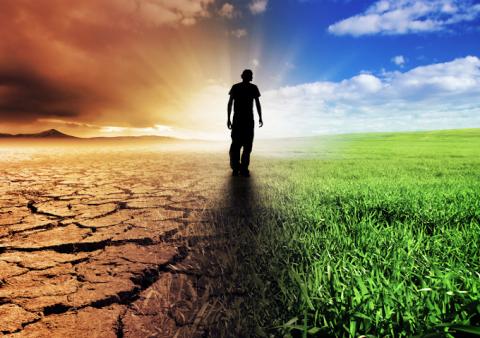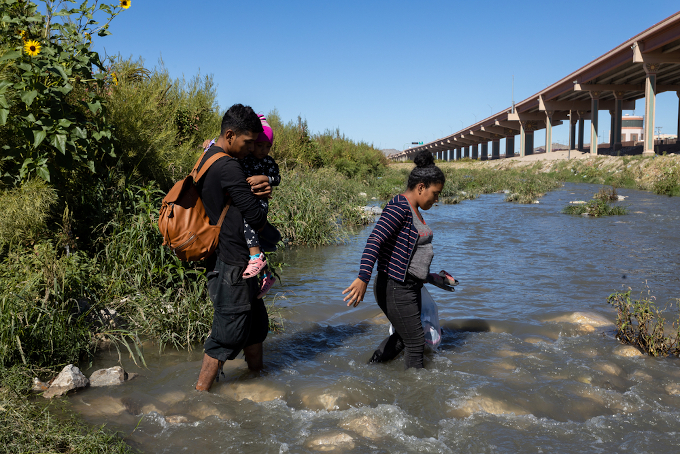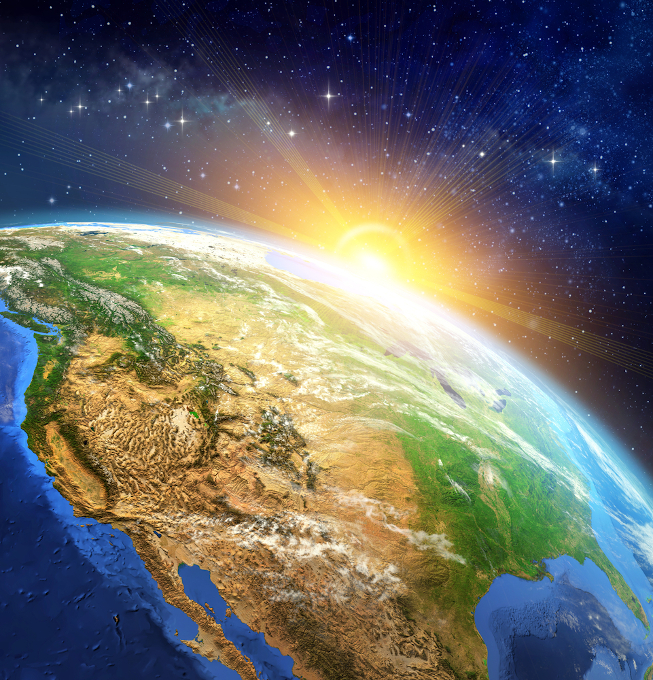Climate Displacement Is Already a Crisis

In the low-lying islands of the Pacific, the relentless rise of sea levels isn't a looming threat, but a devastating present reality. On the other side of the world, in sub-Saharan Africa, farmers confront expanding deserts where their fields once flourished. These are not isolated incidents but interconnected impacts of climate-induced displacement that threatens to erase communities and histories. This crisis transcends traditional borders, our understanding of our environment, and human migration itself, as ecological degradation forces unprecedented numbers of people to leave their homes. While the term “climate refugee” is still finding its footing in international legal discourse, this phenomenon is already reshaping the human geography of our planet, with not only vast environmental and geographical implications but also a high human cost of this emergent form of migration.
Throughout Earth's history, climate has always been a dynamic player, shaping ecosystems and human civilizations alike. The onset of the Industrial Revolution marked a pivotal turn in this natural process. The relentless pursuit of industrialization, powered by fossil fuels, set off an unprecedented increase in greenhouse gas emissions that insidiously reshaped climate patterns worldwide. As factories mushroomed and cities swelled, so too did the levels of carbon dioxide, methane, and other greenhouse gases in the atmosphere. This accumulation created an invisible blanket around the Earth, trapping heat and gradually upsetting the delicate balance of our climate systems. The consequences were not immediate, but by the late 20th century, the signs were unmissable: rising global temperatures, melting polar ice caps, and increasingly erratic weather patterns.
The impact of these climatic changes on human populations began subtly. In rural areas, especially in developing countries, farmers grappled with the unpredictability of weather, with droughts and floods becoming more frequent and severe. Coastal communities witnessed the slow but steady encroachment of the sea, as rising sea levels began to swallow islands and inundate low-lying areas.
Initially, these impacts prompted internal migration, with people moving from affected rural areas to cities in search of stability and livelihoods. As the effects of climate change intensified, the scale of displacement grew, crossing international borders and continents. The term “climate refugees” began to surface in global discourse, capturing the plight of those forced to flee due to environmental disasters; it was a little-known term when it first emerged around 1985 and still, since then, this group remains in a legal limbo, unrecognized by the traditional definitions of refugees under international law. By the 21st century, the concept of climate-induced migration had escalated from isolated incidents to a global phenomenon. The increasingly visible connection between climate change and migration patterns underscored a stark reality: the Earth's changing climate was no longer just an environmental issue but a powerful driver of human displacement and migration.

In the Pacific, small island nations like Kiribati and the Marshall Islands face an existential threat from rising sea levels. As the ocean gradually but surely consumes their land, the residents confront the heart-wrenching prospect of leaving their ancestral homes. This scenario, no longer a grim possibility but a certainty for Pacific Islanders, serves as a harbinger for coastal communities worldwide, foreshadowing the challenges many may soon face. In sub-Saharan Africa, countries like Chad and Niger are battling the relentless advance of the Sahara Desert. The desertification of once-fertile land, compounded by severe droughts, undermines agricultural livelihoods, forcing people to migrate in search of sustenance. In South Asia, nations like Bangladesh and India offer a different yet equally severe scenario, as they confront the increasingly sudden fury of cyclones and floods. The 2020 super cyclone Amphan, displacing millions, is a testament to the escalating intensity of such disasters in the region. These events, which are becoming more and more common, prompt immediate evacuations and, over time, end up reshaping long-term migration trends and geographies as communities seek safer havens.
Meanwhile, in North America, the increasing prevalence of massive wildfires illustrates another facet of climate migration, even if it doesn’t seem like it on the surface. In the United States and Canada, communities ravaged by wildfires face the dual challenge of immediate evacuation and long-term resettlement decisions. In a developed nation like the U.S., we don’t often think of this as climate displacement, but this is an internal type of migration driven by the desire to avoid future climate-related disasters or compounded by the inability to remain in an affected area. After all, insurance companies are now refusing to provide services in areas prone to wildfires and flooding from hurricanes and rising sea levels, halting new construction and giving pause to current residents who face the possible, indeed likely, scenario of having to rebuild their homes with no financial relief from insurers.
This growing crisis of climate-induced migration is not just a local or national issue: it's a global challenge that demands international cooperation and a reevaluation of existing legal frameworks. As climate change redraws the map of habitable zones and pushes populations across borders, the world faces a pressing need to redefine and expand the legal protections for those displaced. Current international refugee law, primarily grounded in the 1951 Refugee Convention and its 1967 protocol, offers protections based on persecution due to race, religion, nationality, membership in a particular social group, or political opinion. But this definition does not encompass those forced to move because of environmental reasons, and so individuals fleeing their homes due to rising sea levels, extreme weather events, or deteriorating environmental conditions often find themselves in a legal limbo, lacking the status and protections afforded to traditional refugees. In other words, current international law makes a clear distinction between migrants and refugees.
We have made some inroads.
Recognizing this gap, international bodies are beginning, or at least attempting, to address the issue. The United Nations Framework Convention on Climate Change (UNFCCC), through mechanisms like the Task Force on Displacement, is exploring ways to protect and assist those displaced by climate impacts. (Incidentally, it was a United Nations office, the UN Environment Program, that first used the term “environmental refugee” in the mid-80s.) The Task Force's mandate includes developing recommendations for integrated approaches to avert, minimize, and address displacement related to the adverse effects of climate change. More recently, the Paris Agreement, a landmark in international climate policy, acknowledges the need for a global response to the impacts of climate change, including displacement. While it doesn't explicitly mention climate refugees, it lays the groundwork for future policies by calling for the strengthening of adaptive capacities and reducing vulnerability to climate change.

We now also have the advantage of modern technological solutions for this modern problem; in the face of escalating climate-induced migration, technology and innovation are playing an increasingly crucial role. Advancements in data science and predictive analytics are proving invaluable in anticipating and managing migration flows. High-resolution satellite imagery, combined with AI algorithms, can track environmental changes and predict areas most likely to experience climate-induced displacement. Organizations like NASA and the European Space Agency are utilizing satellite data to monitor climate patterns, land use changes, and their effects on human populations. These insights can enable governments and humanitarian organizations to prepare more effectively for migration trends and implement targeted interventions.
Likewise, innovations in sustainable housing and infrastructure can help accommodate displaced populations. Architects and urban planners are exploring eco-friendly building materials and designs that are both resilient to climate impacts and sustainable for the environment. Examples include modular homes that can be quickly assembled in response to displacement, and floating houses designed for flood-prone regions. These solutions could not only provide immediate relief but also contribute to long-term sustainability goals. Alongside this architectural modernizations, integration of renewable energy sources is another key aspect of innovative responses to climate migration. For instance, solar and wind energy projects in refugee and displacement camps not only reduce carbon footprints but also improve living conditions by providing reliable and clean energy, and these are already being used in several refugee camps around the world.
But, really, none of this is easy. While international agencies and technology offers promising solutions, challenges such as accessibility, affordability, and the digital divide must be addressed to ensure that these innovations and policies reach the most vulnerable populations.
Despite the steps that the UNFCCC is taking, for example, creating new legal definitions and frameworks is a complex process that requires consensus among nations with diverse interests and priorities. One of the foremost challenges is the absence of this legal framework to specifically address the needs of climate refugees. But there's also the need to balance the sovereignty of states with the rights and protections of displaced individuals, given the fluid scope of “culpability” and responsibilities any given country may have.
For instance, should the United States provide broader protections for climate refugees for being one of the biggest polluters in the world? Looking ahead, the international community faces the task of not only extending legal protections to climate refugees but also ensuring these policies are effectively implemented and funded, even if and especially when they can get thorny. But these effective responses to climate-induced migration demand coordinated international efforts, which are slow to come by at best (see the Paris Agreement) or completely fail at worst (remember when the U.S. pulled out of the Paris Agreement?). This includes shared strategies for disaster response, sustainable development, and humanitarian aid, even if achieving such coordination is a series of complex political maneuvers involving multiple stakeholders with varying perspectives and goals. Another significant challenge lies in securing adequate funding and resources to implement effective migration management and climate adaptation strategies, which should include financial support for developing countries, as they are often the most affected by climate change yet have the least resources to cope with its impacts and contribute less to greenhouse emissions.

We can also try to work with novel solutions beyond the technological ones. Integrating local and indigenous knowledge into climate and migration policies, for example, could prove to be crucial. Local communities often have a deep understanding of their environment and can offer valuable insights into sustainable living practices and resilience-building strategies. Their traditional practices in land management, agriculture, and ecosystem preservation can provide some long-term sustainable solutions. For instance, indigenous techniques of controlled burning have been recognized for their effectiveness in preventing larger wildfires, a practice gaining attention in places like Australia and North America. Local communities, particularly in regions highly vulnerable to natural environmental changes or that face natural extreme conditions, have developed unique ways to adapt to their changing environments: These adaptations include building homes that can withstand extreme weather, conserving water through traditional methods, or cultivating crops suited to altered climatic conditions. By creating a dialogue between local knowledge and scientific research, it can lead to more comprehensive and effective adaptation strategies that are both scientifically sound and culturally sensitive. And for local and indigenous knowledge to have a broader impact, it must be included in national and international policy-making processes to ensure that policies are not only environmentally effective but also, importantly, socially equitable, as inequity oftentimes manifests in cultural differences and institutional biases. Overcoming these barriers requires concerted efforts to provide platforms for these communities and integrate their knowledge into mainstream climate and migration discourse to acknowledge their rights and contributions in managing their resources and ancestral lands.
On the other hand, while much focus is on managing the consequences of climate-induced migration, equal attention must still be given to mitigating the root causes of climate change. This includes global efforts to reduce greenhouse gas emissions, transition to renewable energy sources, and protect and restore natural ecosystems, a path that involves a balanced approach that addresses both immediate migration challenges and long-term climate action. Scientists have already been hard at work and given us myriad possible solutions, so this will mostly require strong political will and an unwavering commitment to international cooperation.
The primary driver of climate change is the increase in greenhouse gas emissions, particularly carbon dioxide, from burning fossil fuels. Global efforts to reduce these emissions, though crucial, have been lax. This includes transitioning to renewable energy sources such as wind, solar, and hydro power, and improving energy efficiency in industries, buildings, and transportation (international treaties like the Paris Agreement can play a key role in setting targets and fostering cooperation among nations to lower emissions).
Deforestation and unsustainable agricultural practices also contribute significantly to climate change. Promoting sustainable land use involves protecting and restoring forests, which act as carbon sinks, and implementing sustainable farming practices that increase biodiversity, enrich soil, and reduce carbon emissions. Indigenous and local knowledge can be particularly valuable in developing these practices. Preventing displacement due to climate change also involves building resilience in communities most at risk. This means not only strengthening physical infrastructure but also supporting economic and social resilience. Initiatives like community-based disaster risk management and resilience-building in urban planning are key components, as they can integrate climate action into localized economic and development policies in a more holistic approach.

Now, continued investment in climate research is essential for understanding and mitigating the impacts of climate change, including migration caused by it. This includes studying climate patterns, developing new technologies for carbon capture and storage, and innovating in climate-resilient infrastructure. Such research can provide the knowledge base for informed policymaking and effective action. In the wake of climate disasters, immediate funding is required for rescue operations, temporary shelters, and basic amenities for displaced populations. But securing this funding can be challenging, especially in a rapidly unfolding crisis. International aid and humanitarian organizations play a pivotal role, but their resources are often stretched thin. And beyond immediate relief, significant investment is needed in long-term adaptation measures like building climate-resilient infrastructure, developing sustainable livelihood options for displaced populations, and protecting vulnerable ecosystems.
Developing countries, which are disproportionately affected by climate change, face particular challenges in funding adaptation and mitigation efforts. These countries often lack the financial resources to adequately prepare for and respond to climate-induced displacements, which is why international financial support, such as grants and low-interest loans from developed countries and international financial institutions, is crucial in bridging this gap. Instruments like the Green Climate Fund and Global Environment Facility are designed to assist developing countries in their climate adaptation and mitigation efforts, but there is a need for greater and more consistent funding from the international community to ensure these mechanisms can meet the growing demand. Even when funding is available, challenges remain in ensuring it is used efficiently and equitably. Corruption, lack of transparency, and bureaucratic inefficiencies can hinder the effective allocation of resources.
The transboundary nature of climate-induced migration is a global issue that goes beyond geographical lines and socioeconomic divides. The stories of displacement from the Pacific Islands to sub-Saharan Africa, from South Asia to North America, are not just isolated tales of hardship but are interconnected threads in the larger narrative of our changing planet. They serve as a poignant reminder that the impacts of climate change are not a distant threat but a present reality, reshaping lives and communities across the globe.
The challenges in addressing climate-induced migration are as diverse as they are complex. From the need for international legal frameworks that recognize and protect climate refugees, to the implementation of national policies and strategies that focus on adaptation and resilience, the path forward requires a concerted effort from all sectors of society. It calls for a synergy between technology and tradition, between international cooperation and local action, all underpinned by a commitment to sustainable development and a deeper respect for our natural world. The journey to effectively manage climate-induced migration is steeped in both challenge and opportunity. It offers a chance to redefine our relationship with the environment, to innovate and collaborate in ways that uplift the most vulnerable, and to forge a future that is not only sustainable but also equitable.
Author Bio:
Angelo Franco is Highbrow Magazine’s chief features writer.
For Highbrow Magazine
Photo Credits: Depositphotos.com































































































































































































































































































































